The Magic of the Marimba
[youtube]giA30-pwcpU[/youtube]
The national instrument and the national symbol
All it takes is one curious tourist, one passerby who glimpses the rich, dark-wood instrument through the entryway. I dare you to step away from the bustle of La Antigua Guatemala’s Calle del Arco, for they are waiting for you—the marimba players of Hotel Posada Don Rodrigo.
If you just venture through the doorway you will instantly be rewarded with a merry burst of whimsical notes. Exotic rings and tolls will swarm around you in melodic cheer.
The hotel’s 10 marimba players have been sharing their talent with La Antigua’s visitors for 35 years. Ten men, 35 years of marimba music. Marimbista Javier Hernández says such unity is integral to their art.
“There are 10 of us and each one needs to understand the others in the group in order for us to stay in harmony,” Hernández says. “And this is something that we have to work at. This is something that is a part of the music, a part of the performance. It’s necessary in order for us to awaken with the music. We need to make the music with courage and strength because that is how we draw in our audience … without an audience you are not a true artist. We have to awaken them.”
The passion behind their fervor to share marimba music comes from the instrument itself, as marimbista Victor Manuel Chok explains: “It’s an emotional instrument and that makes us fight for it. It is something that you feel inside, lifting you. It’s our national pride.”
While historians still debate the origin of the marimba, cultural authorities agree that the marimba and its music is most celebrated in Guatemala. The country has officially woven the instrument into its identity, declaring it the national instrument in 1978 and the national symbol in 1999.
Marimbista Pablo Suy García affirms such rooted sentiment. “For me the music is beautiful because it’s our music from right here in Guatemala. I can perform whatever melody I want and the music rings out as the most beautiful music here in Guatemala.”
Hernández adds that it is the unique qualities of the marimba—the instrument’s special Hormigo wood—that provokes such national pride. “I think because it is made of wood. It is something that is not of metal and it calls to mind a tree or the earth. The marimbas produce sounds that make up a part of the heart of a Guatemalan. Those sounds comfort us.”
The sounds from these marimbistas are resonating notes that spill from two large sets of wooden bars. The instrument resembles a xylophone, only with long tubular or gourd-shaped resonators hanging down from the wooden keys. The marimba at Hotel Posada Don Rodrigo can ring out in 43 different tones.
The marimba players share their music twice daily, the first session beginning at noon and the second beginning at 7 p.m. Enthusiasts can purchase CDs at the hotel, so be sure to stop by and treat yourself to this musical tradition.
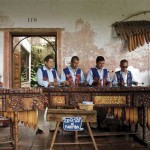
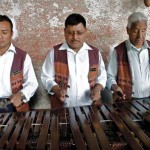
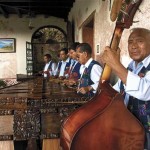
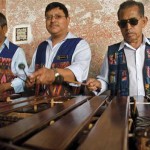
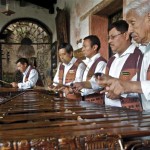
an excellent job…I’ve been thinking of writing about the marimba bands…you beat me to it(and beat me well)…loved the piece. M
Thanks for the shout Michael… I really appreciate it!
Loved the story Laura! Along with all the others you’ve shared. You are so talented, but I think I’ve told you that numerous times.
Hope you are doing well. Always nice to know where you are.
Loved the story Laura, along with the rest that you’ve written. You are so talented, of course, I think I’ve told you that numerous times.
Hope you are doing well. It’s always nice to see where you are.
Thanks Rowe! Great to hear from you!!
Pingback: Marimba Musica: Guatemalan Patrimony | ArteAntigua